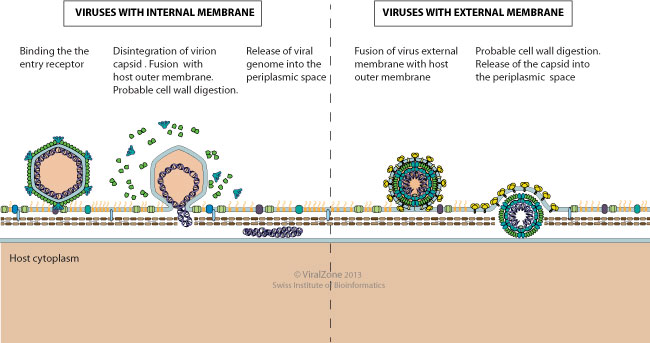Fusion of virus membrane with host outer membrane (kw:KW-1239)
Some bacterial viruses penetrate into their host by fusing their viral membranes with the host outer membrane. The virus lipid membrane involved can be either external (e.g. Cystoviridae) or internal (e.g. Corticoviridae) which in the latter case requires the preliminary dissociation of the surrounding capsid.
The fusion events lead to the release of respectively the viral genome or the capsid into the host periplasmic space  .
.

Penetration of membrane-containing double-stranded-DNA bacteriophage PM2 into Pseudoalteromonas hosts
Kivela HM, Daugelavicius R, Hankkio RH, Bamford JK, Bamford DH
J Bacteriol. 2004 Aug;186(16):5342-54
Kivela HM, Daugelavicius R, Hankkio RH, Bamford JK, Bamford DH
J Bacteriol. 2004 Aug;186(16):5342-54
Penetration of enveloped double-stranded RNA bacteriophages phi13 and phi6 into Pseudomonas syringae cells
Rimantas Daugelavicius, Virginija Cvirkaite, Ausra Gaidelyte, Elena Bakiene, Rasa Gabrenaite-Verkhovskaya, Dennis H Bamford
J. Virol. April 2005; 79: 5017-5026
Rimantas Daugelavicius, Virginija Cvirkaite, Ausra Gaidelyte, Elena Bakiene, Rasa Gabrenaite-Verkhovskaya, Dennis H Bamford
J. Virol. April 2005; 79: 5017-5026
Bacteriophage receptors, mechanisms of phage adsorption and penetration into host cell
Rakhuba DV, Kolomiets EI, Dey ES, Novik GI
Pol J Microbiol. 2010;59(3):145-55
Rakhuba DV, Kolomiets EI, Dey ES, Novik GI
Pol J Microbiol. 2010;59(3):145-55
Matching UniProtKB/Swiss-Prot entries
(all links/actions below point to uniprot.org website)1 entry grouped by protein
1 entry
